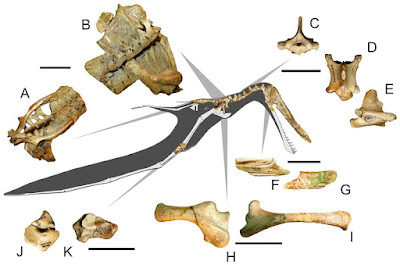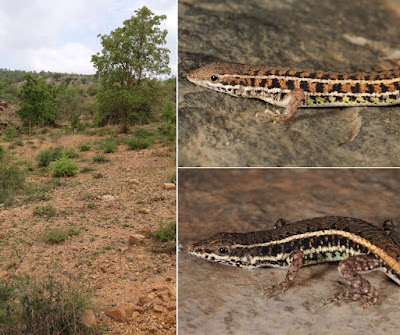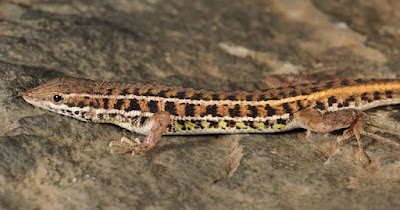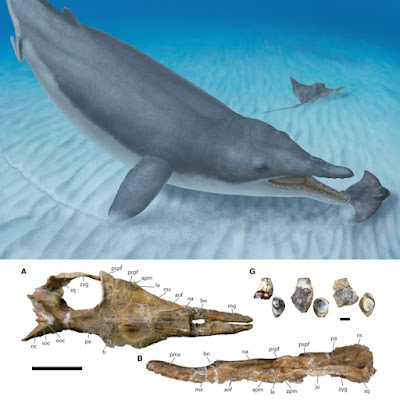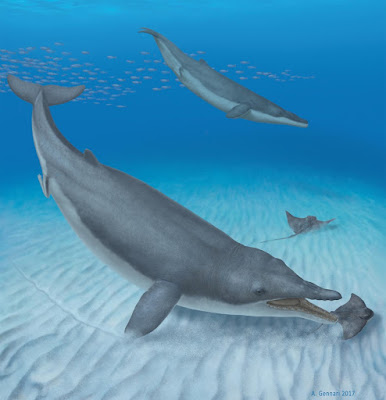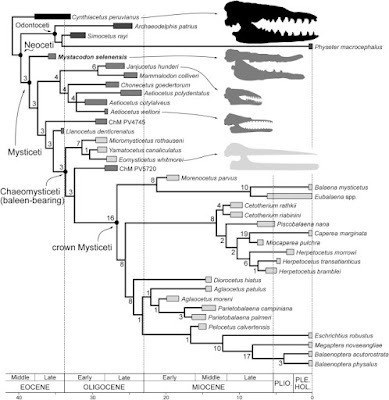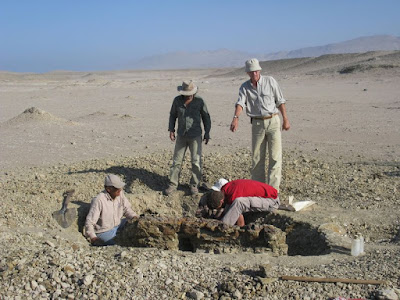![]() |
Zuul crurivastator
Arbour & Evans, 2017 |
Abstract
The terrestrial Judith River Formation of northern Montana was deposited over an approximately 4 Myr interval during the Campanian (Late Cretaceous). Despite having been prospected and collected continuously by palaeontologists for over a century, few relatively complete dinosaur skeletons have been recovered from this unit to date. Here we describe a new genus and species of ankylosaurine dinosaur, Zuul crurivastator, from the Coal Ridge Member of the Judith River Formation, based on an exceptionally complete and well-preserved skeleton (ROM 75860). This is the first ankylosaurin skeleton known with a complete skull and tail club, and it is the most complete ankylosaurid ever found in North America. The presence of abundant soft tissue preservation across the skeleton, including in situ osteoderms, skin impressions and dark films that probably represent preserved keratin, make this exceptional skeleton an important reference for understanding the evolution of dermal and epidermal structures in this clade. Phylogenetic analysis recovers Zuul as an ankylosaurin ankylosaurid within a clade of Dyoplosaurus and Scolosaurus, with Euoplocephalus being more distantly related within Ankylosaurini. The occurrence of Z. crurivastator from the upper Judith River Formation fills a gap in the ankylosaurine stratigraphic and geographical record in North America, and further highlights that Campanian ankylosaurines were undergoing rapid evolution and stratigraphic succession of taxa as observed for Laramidian ceratopsids, hadrosaurids, pachycephalosaurids and tyrannosaurids.
KEYWORDS: Ornithischia, Thyreophora, Ankylosauria, Ankylosaurinae, Cretaceous, Campanian
Systematic palaeontology
Dinosauria Owen, 1842
Ornithischia Seeley, 1887
Thyreophora Nopcsa, 1915
Ankylosauria Osborn, 1923
Ankylosauridae Brown, 1908
Ankylosaurinae Brown, 1908
Ankylosaurini Arbour and Currie, 2016
ZUUL gen. nov.
Type and only known species: Zuul crurivastator gen. et sp. nov.
Etymology: The generic name refers to Zuul the Gatekeeper of Gozer, a fictional monster from the 1984 film Ghostbusters, and the species epithet, crurivastator, combines crus (Latin) for shin or shank, and vastator (Latin) for destroyer, in reference to the sledgehammer-like tail club.
Holotype: ROM 75860.
Diagnosis: Differs from all ankylosaurids in the possession of the following autapomorphies: imbricated, peaked frontonasal and frontoparietal caputegulae; prominent longitudinal furrows on the lateral surface of the squamosal horn; lateral caudal osteoderms along the tail club (excluding the knob osteoderms) are strongly concave on the leading edge with posteriorly offset apices; tail club knob dorsoventrally flat, with height to length ratio less than 0.20. Zuul can be further differentiated from other ankylosaurins in the following traits: possesses pyramidal prefrontal, frontoparietal and middle supraorbital caputegulae (unlike the conical caputegulae in Nodocephalosaurus and Talarurus); squamosal horns extend posteriorly well past the nuchal shelf, similar to Scolosaurus but unlike Anodontosaurus, Euoplocephalus, or Ziapelta; postocular caputegulae small and sparsely distributed, similar to Scolosaurus but unlike Anodontosaurus, Euoplocephalus or Ziapelta. Caudal osteoderms lateral to tail club handle are proportionately larger and more sharply pointed than in ankylosaurines from the Nemegt Formation of Mongolia.
![]()
![]() |
Life restoration of Zuul crurivastator.
Illustration: Danielle Dufault |
![]() |
Zuul crurivastator size compared to an African elephant Loxodonta africana.
Illustration: Danielle Dufault |
Holotype locality: Approximately 5 km northwest of the John Wodarz Bridge, in badlands exposures of the Judith River Formation outcropping along the north side of the Milk River Drainage near the City of Havre, Montana (Section 35, Township 33N, Range 15E). GPS coordinates for the quarry are reposited at the Royal Ontario Museum. The site was originally designated Theropoda Exp LLC Locality LC02(Q).
Stratigraphic horizon and age: Coal Ridge Member of the Judith River Formation. The Coal Ridge Member was deposited between 76.2 and 75.2 Ma.
![]() |
Figure 6. Overview of the tail of Zuul crurivastator ROM 75860 in dorsal view, with insets of detailed anatomy.
(a) Field of ossicles in the anterior portion of the tail. (b) Detail of the neural arches of the handle caudal vertebrae, and ossified tendons. (c) Left caudal osteoderm from the seventh pair. (d) Preserved epidermal sheath on the right caudal osteoderm from the second pair. (e) Preserved epidermal sheath on the right caudal osteoderm from the third pair. (f) Epidermal scales lacking bony cores, arranged in a transverse row at the third pair of caudal osteoderms. (g) Close-up of the tail club knob. |
![]() |
The knob of bone forming the sledgehammer-like tip of the tail in Zuul crurivastator.
photo: Brian Boyle/Royal Ontario Museum |
Conclusion:
ROM 75860 represents a new ankylosaurine genus and species, Zuul crurivastator from the Judith River Formation. The holotype specimen is one of the most complete dinosaur skeletons from this formation, and is the first ankylosaurid skeleton described from this unit. Remarkably, ROM 75860 is the first ankylosaurin skeleton known with a complete skull and tail club, and it is the most complete ankylosaurid ever found in North America. The presence of abundant soft tissue preservation across the skeleton, including in situ osteoderms, skin impressions and dark films that probably represent preserved keratin, make this exceptional skeleton an important reference for understanding the evolution of dermal and epidermal structures in this clade. The recognition of Z. crurivastator from the Judith River Formation fills a gap in the ankylosaurine stratigraphic and geographical record and further highlights that Laramidian ankylosaurines were undergoing rapid evolutionary rates and stratigraphic turnover as observed for Laramidian ceratopsids, hadrosaurids, pachycephalosaurids and tyrannosaurids. The excellent preservation of ROM 75860 and the abundant diversity represented elsewhere in the same quarry highlight the potential for significant new fossil discoveries in the upper Judith River Formation and emphasize the need for continued work in this historically significant geological unit.
Victoria M. Arbour and David C. Evans. 2017. A New Ankylosaurine Dinosaur from the Judith River Formation of Montana, USA, Based On An Exceptional Skeleton with Soft Tissue Preservation.
Royal Society Open Science. DOI:
10.1098/rsos.161086



